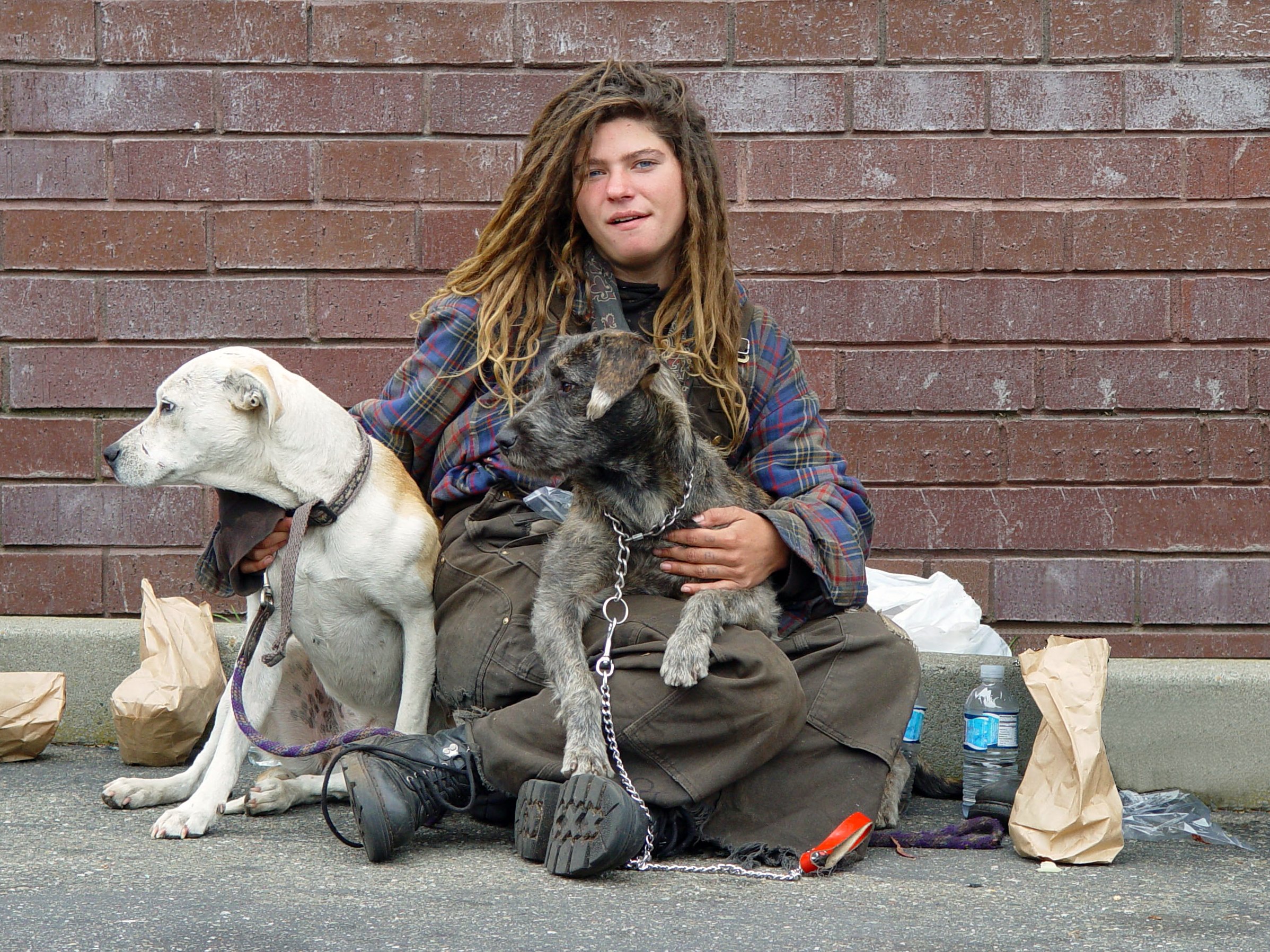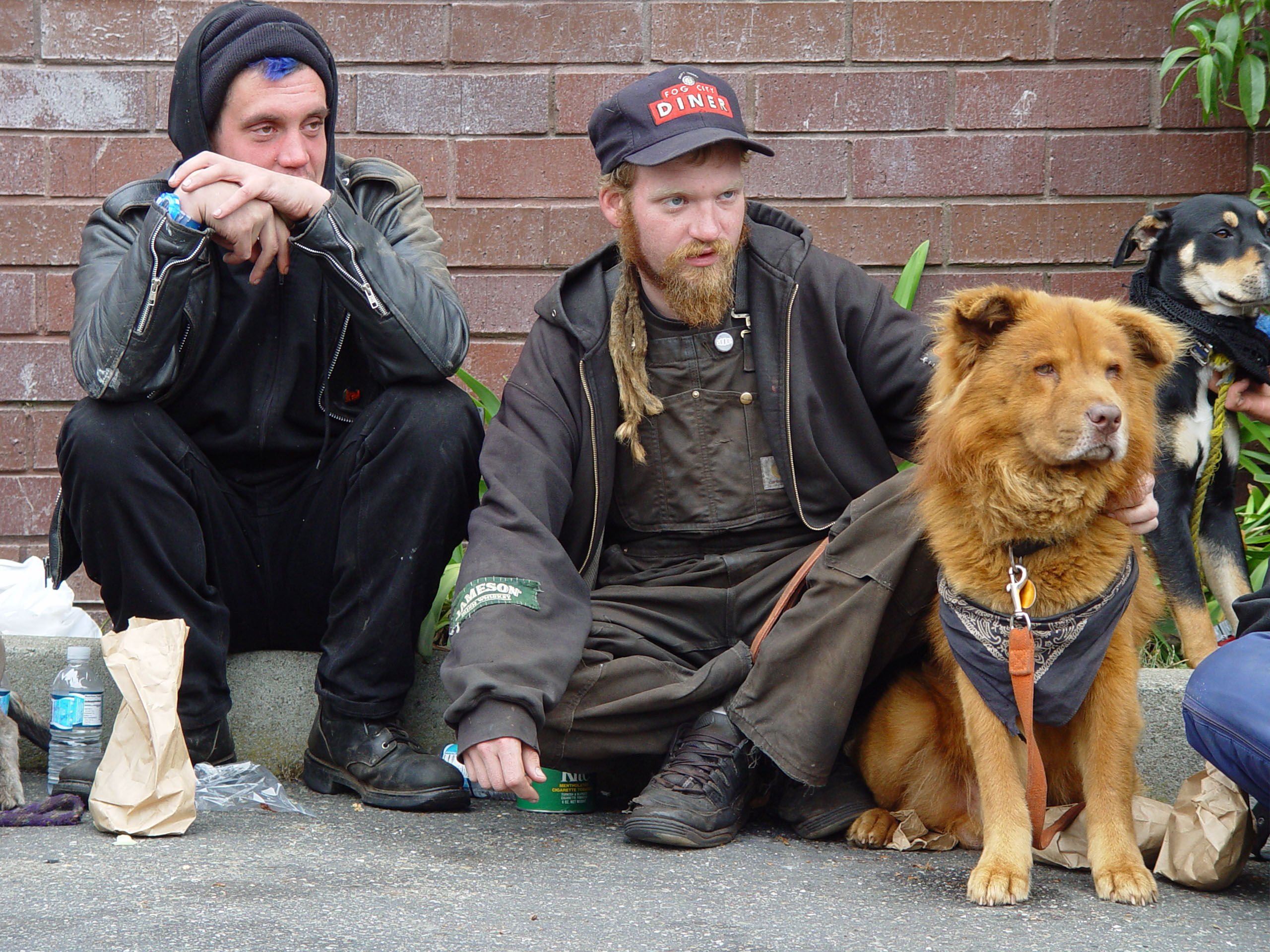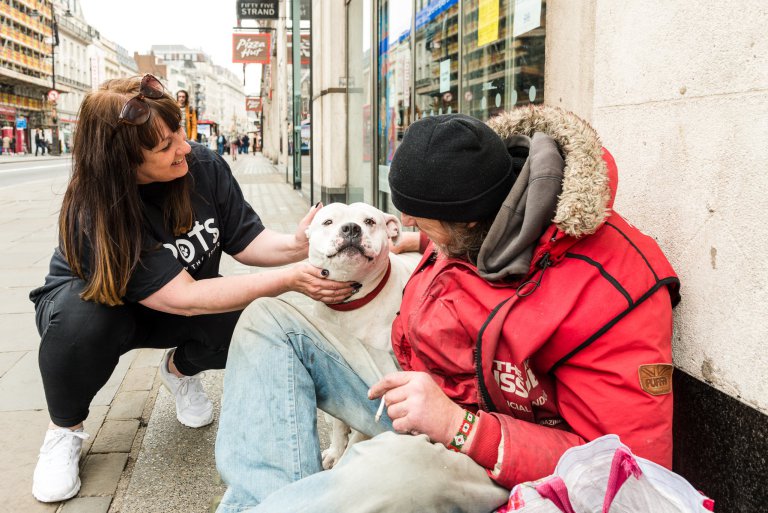Whenever I walk home a little drunk after a night out, I inevitably give all my cash to the homeless guy who sits outside the tube. Honestly, the reason I give my money to this particular homeless man is his sweet old Staffie-cross Kirsty, who sits at his feet with the deflated rugby ball that she permanently carries in her mouth. I guess I worry as much about the dog as I do about him: as with all animals, it feels like she’s in an especially vulnerable situation, wholly dependent on the kindness of humans. And caring about the dog really means caring about the owner; the wellbeing of one very often hugely dependent on the welfare of the other. For most homeless people with dogs, their four-legged companion keeps them going day-to-day, offering emotional support that is no less important or valid than that given by a therapy dog or service animal. Unlike many human friendships on the streets, pets provide comfort without judgement, loyalty, warmth and security. They also offer the owner an element of routine and responsibility in feeding them regularly and, especially for women and disabled, they offer protection.
In America, five to ten percent of homeless people have dogs and/or cats, and in some areas of the country the rate is as high as 24%. Although there are no definite statistics, UK figures are estimated to be similar, around 5%. It used to seem unfair to me that dogs have to suffer on the street alongside their homeless owners, and I know lots of people who still see the act of owning a dog on the street as ‘selfish’. But more recently I’ve started to wonder if dogs like Kirsty are leading happier lives than many pets that belong to affluent owners, for whom the animal plays a less central role in their lives. A homeless person’s dog is with them 24/7, whereas many, if not most, people earning regular salaries will have to go out to work each day and leave their dog alone for extended periods of time. The PDSA found that a third of dogs in the UK are ‘overweight’ or ‘obese’ and it’s likely that there will be more overweight pets than healthy ones by 2020. In the last five years there’s been a 900% increase in cases of dog and cat diabetes. This suggests that many dogs aren’t getting enough exercise; they are leading comfortable but sedentary lives: distressingly, the PDSA reports that a quarter of a million dogs in the UK don’t get walked at all. These dogs are often bored in a way that dogs living with people on the streets are not. One homeless woman describes how her dog “wakes up so excited every morning and gets so happy about the littlest thing, like rolling around in the grass or even just the weather being nice. Seeing her like that reminds me to stay happy for simple things too.”

Photo by Franco Folini: Homeless woman with dogs, Haight Street, San Francisco
There are many who still think that these dogs can’t possibly be enjoying the same quality of life as those who have warm beds to sleep in, organic pet food, baskets of dog toys and so on. And yes, a dog on the street is probably going to be living a ‘harder’ life than, for instance, my pampered cavalier. But we shouldn’t be too quick to assume that humans really know what’s best for a dog, what really makes a dog happy. A recent research paper found that living in a pampered human environment can actually be more stressful to animals than we think. The researchers found that free-ranging dogs living on Bali Island (who have been free for thousands of years) have more positive personality traits than the pet dogs adopted by expatriates and kept restricted to their houses and backyards, as is typical in modern western cultures. The researchers found that free-ranging Bali dogs were rated as less active, less excitable, less aggressive towards animals, and less inclined to chase animals or humans than Bali dogs living as human companions. The results suggest that a change in lifestyle, i.e. living in a confined environment, has negative consequences on some canine personality traits, such as over excitability, aggression towards animals, and prey drive.
So we can see that the human-animal bond isn’t always offering equal benefits, and perhaps the trappings of modern human society aren’t actually catering to the basic needs of our dogs. Many of us are guilty of being distracted by all our technology, finding less time to play with and attend to our beloved companions. We are busy with work, with social media, with ‘projects’, meaning we’re less likely to prioritise long dog walks outside. It’s too easy in our time-poor worlds to show our dogs affection with extra food treats rather than playtime. The homeless woman whose dog loves rolling around on a sunny morning says “In my mind she’s a little angel that saved me as much as I saved her.” That is perhaps an example of the human – animal bond at its strongest: a mutually beneficial relationship that enhances the life of both owner and dog. When you really need your dog in your life for emotional support, that animal becomes less of an accessory and more of a valued friend. Certainly, abuse can happen in all these relationships, but I don’t think the chances are any higher on the streets (this would be an interesting study for future research). Ultimately, owning a dog is a drain on valuable resources – to make that commitment as a homeless person suggests a deep level of care for the animal. Indeed, charity Pets of the Homeless state that some homeless people would sacrifice their own food for their pets. For anyone wanting to read more, there’s a brilliant book, My Dog Always Eats First: Homeless People and Their Animals, that investigates the role that animals play in the lives of homeless people.

Photo by Franco Folini: Homeless guys with dog, Haight Street, San Francisco
Caring for a dog on the streets is of course more challenging than living at home with a regular vet and online deliveries of pet food. In Bath last weekend I saw a Big Issue seller cleaning up after his dog who’d had diarrhoea outside Waitrose. It’s certainly much harder for him to get his animal medical care than it would be for another owner. Still, help is available. in the UK, the Dogs Trust Hope Project helps dog owners who are homeless or in housing crisis, providing advice as well as free and subsidised veterinary care for their dogs as well as dog-friendly hostels. The Dogs on the Streets (DOTS) project also offers rough sleepers free veterinary check-ups, food, training advice and grooming one day a week. In the US, there is support available from fortnightly free pet care at the Union Gospel Mission to food distributed by organisations like Pets of the Homeless. The woman quoted earlier feeds her dog at specific times with foods recommended by the vet, and she gets money for this food from panhandling. These organisations will also offer temporary shelter or care for pets in emergency situations: some homeless people won’t go to a hospital when they are in need of medical treatment because they have no one to care for their pet or fear the authorities will take their pet away from them.
 DOTS Michelle greets a returning customer, Image by Jerry Syder
DOTS Michelle greets a returning customer, Image by Jerry Syder
Ultimately, it is not inherently unfair for a homeless person to keep a dog. What is unfair is for an affluent or comfortable person to judge a homeless person for keeping a dog. As Pets of the Homeless point out, “Finances don’t indicate who a person is, what they are capable of, how much love they deserve or where it should come from. Poverty is not a character trait. A struggling person deserves the same intimate connections as everyone else”. If you are worried that a dog on the street isn’t being well cared for, talk to the owner; offer money or pet food to help. Support organisations like those listed above. With a little more understanding and a little less judgement, we might even learn something about caring better for our own pets.

A lovely piece, and lovely photos. Thank you.
Thank you Michael, so glad you like it.
Do you mind if I share this post, along with the top photo, on my Facebook page? Michael https://www.facebook.com/Michael-Brandow-537349632950520/
Please do! The photo you mention is one I got online, copyright-free in the public domain. Let me try to find out the photographer so we can both credit them properly!
No luck – it’s reused on a few sites but uncredited each time. So I guess our photographer will remain a mystery…
This is very kind of you. Many thanks. I’m very interested in dogs of “the homeless” and touch upon them in this piece for your reading pleasure: http://www.michaelbrandow.com/single-post/2018/05/05/Digging-at-the-AKC-Library
Fascinating piece! I thought your comments about being attracted to the darker puppy because of her smell were so interesting (“I’ve always trusted my nose when it comes to decisions of the heart, and it’s one of the reasons I so admire dogs and the shameless priority they put upon smell”). Have you read Bekoff’s latest book, Canine Confidential? The passages on dogs’ noses are spellbinding. Also, the way you describe all the mutilations of extreme dog breeding is incredibly powerful. I wish more people were aware of these issues.
What a wonderful post! Thank you for your insights, and for your kind words about my book, My Dog Always Eats First.
Thank YOU for your kind comment, Leslie, and for your wonderful book!
They provide essential companionship.
thank you for this, just started donatind to dots straight away. tonite on my way home for a gig found two different holess woman with dogs and just had to stop to help… came home and found ur post. one of the women was sleeping and pretty unresponsive, was worried so got staff at kings x train station to check.. the lil dog was defending her so fiercely… she didnt even wake up. . ended up going buying a bunch of food for both her and the dog, some water… left the doggy eating and drinking and everything else next to the owner for when she wakes up. Turned out theres was another woman there with a dog when i got back from the shopping so gave the doggy some of the food i had for the other doggy, water and gave the women the lil cash i had on me. I just wish i could help more to be honest.
. ended up going buying a bunch of food for both her and the dog, some water… left the doggy eating and drinking and everything else next to the owner for when she wakes up. Turned out theres was another woman there with a dog when i got back from the shopping so gave the doggy some of the food i had for the other doggy, water and gave the women the lil cash i had on me. I just wish i could help more to be honest. 
Thank you so much for stopping to help – you obviously have a big heart and I wish everybody cared as much as you do. The way the little dog was defending the first woman I will look out for them next time I’m at Kings Cross late at night xx
I will look out for them next time I’m at Kings Cross late at night xx
Your page helps me a lot and I am so thankful for sharing your wonderful page.